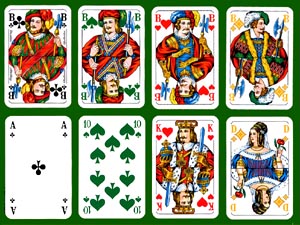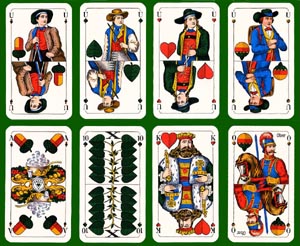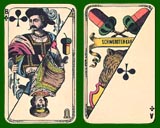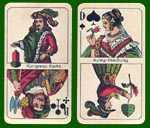
Skat is played mostly in the north and west of Germany, where the modern preference is for French-suited cards (clubs, spades, hearts, diamonds) of traditional German design, with K for König, D for Dame, and B for Bube. The traditional black-red suit distinctions are retained, but those illustrated below are in four colours, a fairly recent innovation promoted by the originators of "Synchron" cards for playing duplicate Skat. Green for spades corresponds to the colour of the equivalent German suit of leaves, yellow for diamonds to that of the equivalent German suit of bells, with red for hearts being common to both. These are the ones I most prefer to play with, though one of my friends can't get used to them and insists on sticking to the old red and black.

Synchron four-colour cards
Many German players still prefer the traditional German pack with suits of acorns (Eicheln), leaves (Laub or Grün), hearts (Herz or Rot), and bells, specifically hawk-bells (Schellen). The court cards are K for König, O for Obermann (Over or senior officer), and U for Unter (Under or junior officer).
There are several different regional patterns of German-suited cards, most of which include a Daus (Deuce) instead of an Ace. Illustrated below are the principal cards of one of several regional patterns. (Württemberg. Although the apparent Ace of acorns bears the index A for As, the fact that it depicts two acorns in each half shows that it is historically a Deuce.)

Württemberg pattern (old style)
Attempts have been made to combine the two suit systems so that players from different regions competing in national tournaments could hold their cards in such a way as to reveal whichever system they were more comfortable with.
Two examples of so-called "Congress Cards" are shown below. Those with a diagonal division were produced by C L Wüst of Frankfurt-am-Main around 1887; the horizontally-divided ones are Altenburger Kongreßkarten from about 1927. Such cards have never proved popular, and it remains to be seen whether the four-colour suit reconciliation attempt ("Synchron") will survive.


Congress cards (1887 and 1927)